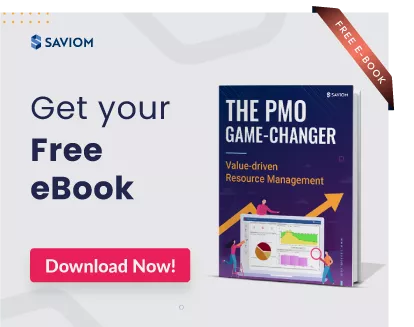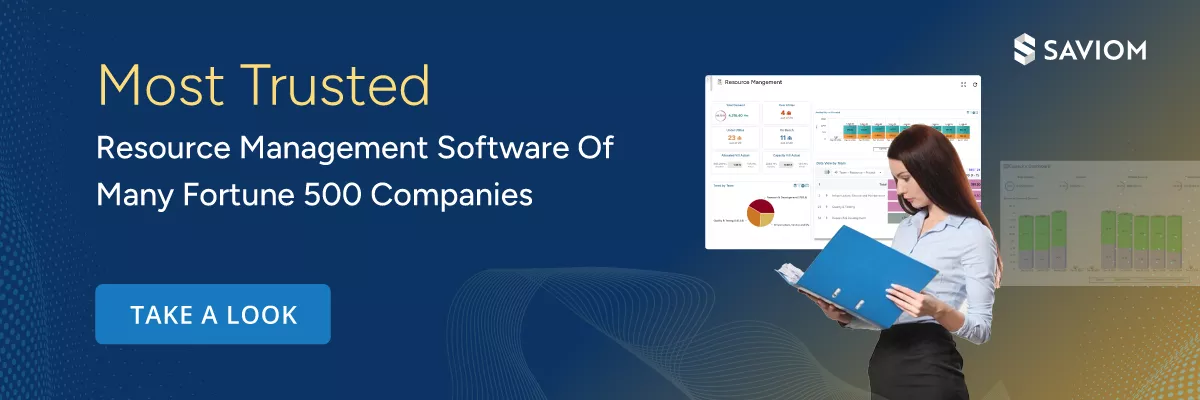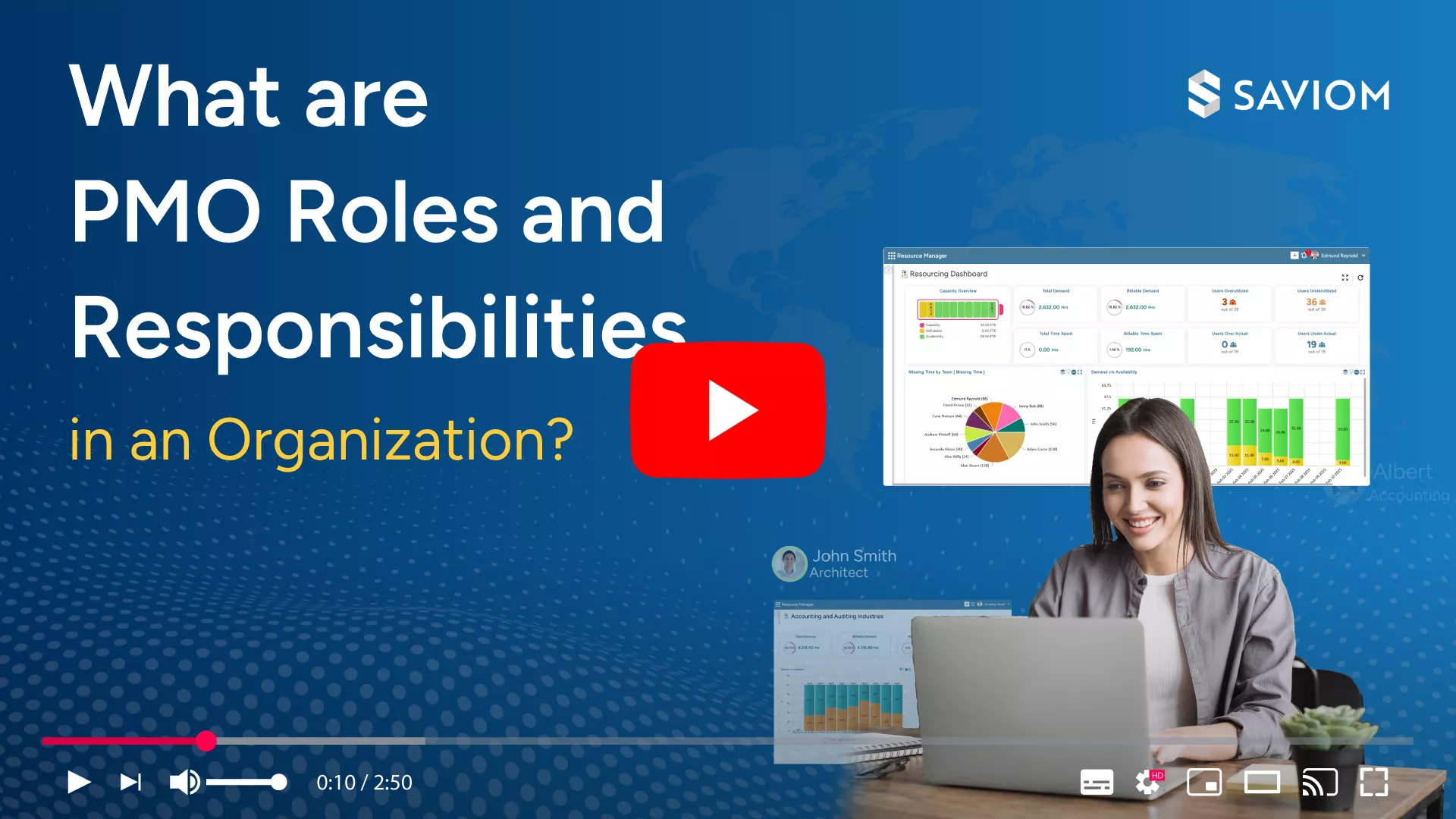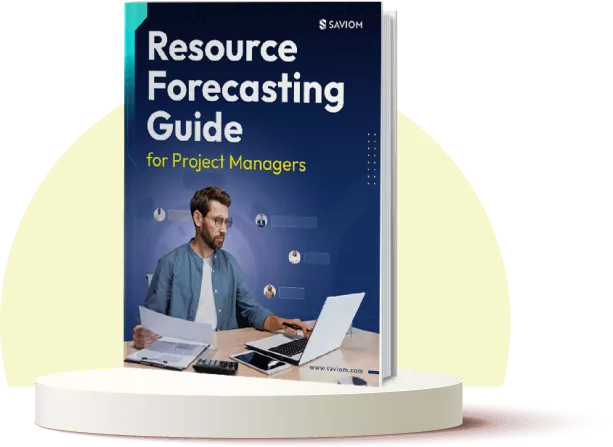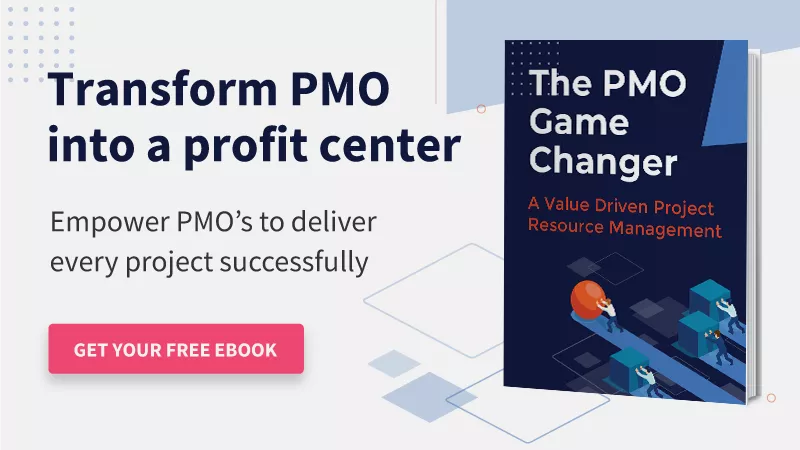With increasing business complexity and multi-faceted initiatives, the Project Management Office (PMO) has evolved from a supporting function into a critical strategic pillar. A well-structured PMO optimizes resource utilization, delivers portfolio-wide visibility, and ensures every initiative aligns with overarching business goals and delivers measurable value.
It serves as the central hub that enables leaders to anticipate risks, control costs, and maximize value from every initiative. As a result, PMOs ensure that projects are delivered with efficiency, consistency, and accountability, without compromising on quality.
Therefore, understanding the PMO roles and responsibilities is crucial for firms seeking to reduce project costs, navigate market volatility, and enhance operational efficiency.
This blog will provide valuable insights into the significance of having a project management office, its primary roles and responsibilities, and how it contributes to successful project outcomes.
But first, let’s understand what is PMO.
What is PMO (Project Management Office)?
As per PMBOK 5th edition, “PMO is a management structure that standardizes the project-related governance processes and facilitates the sharing of resources, methodologies, tools, and techniques.”
A Project Management Office (PMO) refers to a group, department, or entity within the organization responsible for providing management reports, establishing guidelines, and a governance framework.
The primary role of the PMO is to establish and maintain project management standards, processes, and best practices, ensuring that projects are executed efficiently. Furthermore, they also ensure optimal utilization of resources and help businesses achieve strategic objectives.
Now that you know the definition of PMO, let’s understand its various types.
Types of Project Management Office in an Organization
A PMO isn’t one-size-fits-all. While one type may be best suited for an organization, it might not work for another. Therefore, when exploring the Project Management Office, it is vital to understand the various types as well. Although all PMOs aim to serve a single purpose, no two operate in the same way.
Here are a few types –
Types of Project Management Office Based on Organizational Structure
These types of PMOs refer to how they govern and manage projects across different levels in an organization, i.e., project, program, and portfolio.
Project Management Office
A Project Management Office is focused on supporting project managers and their teams in successfully delivering individual projects. It provides guidance, best practices, templates, and tools to ensure consistency and efficiency in project management practices.
Program Management Office
The PMO’s tasks involve overseeing a group of related projects that are aligned with a specific program or objective. It focuses on managing project interdependencies, resolving conflicts, and ensuring that projects achieve organizational goals without setbacks.
Portfolio Management Office
The Portfolio Management Office oversees the entire portfolio of collective projects and programs across the organization. It manages the allocation of resources, prioritizes projects based on strategic objectives, and monitors performance across the various programs.
Dive deeper: Project vs. Program vs. Portfolio Management: How Are They Different?
Types of Project Management Office Based on Function
The following types of Project Management Office refer to the extent of support, control, or authority they have over project activities and decisions.
Enterprise-Level PMO
An enterprise-level project management office is responsible for aligning project management tasks with the organization’s overall strategy and goals. It oversees all program and project management responsibilities across the organization and ensures that projects and programs align with its overall strategy.
Supportive PMO
This PMO supports and guides project managers as and when required. It focuses on creating a framework of processes, governance, training modules, and mentoring programs that help project managers in their daily operations. Usually, a supportive PMO functions as a consultative entity.
Controlling PMO
A controlling PMO focuses on enforcing project management functions and standards across the organization. It reviews and approves project plans, monitors project progress, and identifies potential risks or issues. The controlling project management office also ensures that projects align with the organizational objectives.
Directive PMO
This type of PMO positions itself as a decision-making authority with a higher degree of control over projects. A directive PMO operation includes assigning project managers, providing resources and support to managers, and controlling the project budget and schedule.
Now that we are aware of what PMO is in project management and its various types, let’s delve into its roles and responsibilities.
PMO Roles and Responsibilities
The role of a PMO typically encompasses diverse responsibilities spanning across the organization. Let us look at the various PMO roles and responsibilities –
Project Management Office Roles
The most commonly found PMO roles in an organization are:
PMO Director
The PMO Director is typically a senior-level executive who oversees the entire PMO function within an organization. They are accountable for aligning project objectives with the company’s strategic goals and ensuring that projects are executed effectively.
PMO Manager
The PMO manager definition is simple. They are the operational leader who are responsible for the day-to-day management and implementation of processes and methodologies. The PMO leader oversees project managers and ensures that projects are delivered on time, within budget, and to the required quality standards.
PMO Analyst
PMO Analysts provide analytical support to the PMO team and project managers. They collect and analyze reports and data, such as project schedules, budgets, and performance metrics, for identifying trends, issues, and opportunities for improvement.
Explore further: Ten Best Practices For PMO Resource Management
PMO Consultant
PMO consultants are external experts who offer strategic advice on project governance, process improvement, and organizational change management. They also bring industry best practices to help organizations optimize their project management functions, ensuring that deliverables align with business goals.
PMO Administrator
The PMO Administrator plays a key role in providing administrative support to the PMO team and project managers. They maintain project documentation, track resource schedules, coordinate meetings and training, and assist with budgeting and financial tracking.
After understanding the various PMO roles, let’s review the key job responsibilities of a PMO.
Project Management Office Responsibilities
The following are some of the PMO job responsibilities in any project-based organization:
Project Prioritization & Governance
The PMO develops standard project selection criteria to prioritize projects in the pipeline based on strategic goals, resource availability, and potential ROI. It also defines and implements methodologies and a governance framework, including risk management, change control, and quality assurance processes, to ensure that projects are initiated, executed, and monitored in accordance with the set guidelines.
Continue reading: 5 Project Selection Criteria to Structure the PMO
Resource Planning & Scheduling
The Project Management Office forecasts the resource demand for the pipeline projects in the opportunity or approval stage and assesses available resources and their attributes. Accordingly, they identify resource gaps and develop comprehensive resource plans. This helps them strategically allocate resources according to the demand and meet project objectives and deadlines effectively.
Resource Optimization
PMO ensures the efficient utilization of human, equipment, financial, and other resources to meet organizational objectives. Further, it also tracks resource usage and identifies instances of over- or underutilization. Accordingly, they direct managers to take necessary steps to mitigate the same and ensure optimal workforce utilization, thus maximizing resource productivity.
Workflow Management
The Project Management Office plays a pivotal role in ensuring seamless workflow management throughout the project lifecycle. This includes establishing standardized workflows for resource requisition, allocation, etc., and implementing templates, tools, and technologies to streamline project execution.
Learn more about resource requisition: How to Create an Efficient Resource Request Workflow?
Stakeholder Management
The Project Management Office facilitates clear communication channels between stakeholders and project managers to ensure alignment of goals, expectations, and activities throughout the project lifecycle. This includes regular status updates, progress reports, and meetings with key stakeholders. All of this helps gather feedback, address stakeholder concerns, and manage conflicts for successful delivery.
Knowledge Management
The PMO maintains a centralized repository where project plans, templates, lessons learned, and best practices are stored and made easily accessible to project teams and stakeholders. Additionally, the PMO provides training and development opportunities for managers and team members to enhance their project management skills and competencies.
Now that we understand the various PMO roles and responsibilities, let’s learn about the difference between a PMO vs. Project Manager.
PMO vs. Project Manager: The Difference
Here is a clear breakdown of the difference between a Project Management Office and a project manager:
| Aspect | PMO (Project Management Office) | Project Manager |
|---|---|---|
| 1. Scope of Responsibility | Establishes and maintains project management standards, methodologies, processes, and tools across the organization. | Responsible for the day-to-day management and execution of a specific project within scope, schedule, budget, and quality constraints. |
| 2. Governance | Provides governance, support, and oversight for multiple projects. | Leads the project team, tracks progress, and addresses issues to keep the project on track. |
| 3. Stakeholder Management | Involved in high-level stakeholder engagement activities across projects. | Primarily responsible for stakeholder engagement at the project level. |
| 4. Knowledge Management | Establishes knowledge management repositories and facilitates knowledge sharing across projects. | Manages project documentation, lessons learned, and best practices within the project. |
| 5. Performance Measurement | Establishes key performance indicators (KPIs) and metrics to measure project and portfolio performance. | Monitors project performance against predefined objectives, milestones, and deliverables. |
Now, let’s read through the significance of PMOs.
What are the Benefits of a Project Management Office (PMO)?
As per a PMI survey, “66% of projects of an organization with a PMO are successful.”
This statistic highlights the importance of having a PMO and how it helps organizations deliver projects successfully within time and budget.

Enables Real-Time Visibility Across the Enterprise
Project Management Office replaces silos of spreadsheets with a centralized system. It enables the PMO department to collect data directly from the originating sources and makes them visible to different stakeholders as per their specific roles.
It further streamlines communication, enhances project tracking, and empowers executives, project managers, and team members with up-to-date insights, ultimately driving greater efficiency across the entire organization.
Reduces Project Resourcing Cost
As per a survey, “A PMO can help organizations reduce costs by up to 20%!”
A PMO does forward planning and allocates the right resources for the right projects at the right time. This approach minimizes the need for last-minute, expensive recruitment and helps reduce project resourcing costs significantly. Further, as the right resources are available during the project initiation, it ensures the timely completion of the project. Hence, this increases profitability and improves customer satisfaction.
Ensures Optimal Utilization of Resources
PMO can track future resource demand and forecast billable, non-billable, and strategic utilization. Hence, PMOs can proactively mobilize resources from non-billable to billable and strategic work.
Further, PMOs can check whether a resource is over-/underutilized and take course corrective measures to ensure optimal utilization. This maximizes productivity and prevents employee burnout.
Want to know more about resource utilization? Read these blogs:
- How to Optimize Resource Utilization in 7 Effective Steps?
- How to Track Resource Utilization? A Step-by-Step Guide
Helps in Business Decision Making
A Project Management Office’s job includes tracking major KPIs and forecasting metrics related to the projects, programs, portfolios, resources, risks, etc. These reports enable stakeholders to assess project health, allocate resources judiciously, and align projects with strategic goals. Thus, the PMO’s data-driven approach not only aids in identifying trends and potential issues but also facilitates proactive decision-making, eliminating potential bottlenecks.
Future-Proofs the Workforce Against Market Volatility
A Project Management Office does capacity planning to forecast shortages or excesses of resources due to market volatility. It helps build an optimized workforce and ensures that the business is not affected by market volatility.
Furthermore, PMOs can create the right mix of contingent and permanent employees to meet future project demand. This helps PMO leaders to reduce costs and enable the business to mitigate risks in the fast-changing market conditions.
Explore more on how a PMO benefits businesses: Top 10 Business Benefits of a PMO
Knowing the benefits of a PMO, let’s see how an organization can set up a successful PMO.
How to Establish a Successful PMO in Your Organization?
Creating a Project Management Office (PMO) within an organization requires a systematic approach involving a series of sequential steps.
Let’s understand each of them in detail.
Assess the Current State of Project Management
Before establishing a PMO, organizations should assess existing project management practices and identify the strengths and gaps. Further, firms can also gather feedback from project teams and stakeholders to gain insights into the pain points.
This in-depth assessment will provide a baseline for understanding the organization’s current project management state, ultimately helping you tailor the PMO’s objectives and strategies.
Determine the Specific Purpose of Your PMO
The next step is to clearly define the purpose and objectives of your PMO. For example, if the goal is to enhance project delivery, the Project Management Office can streamline internal processes and establish best practices for all project managers to follow.
Alternatively, if the goal is better risk management, the PMO can establish guidelines for identifying, categorizing, and mitigating risks. Therefore, setting goals helps PMOs to consolidate their efforts and ensure success.
Want to know more about risk management? Continue reading: What is Enterprise Risk Management? 9 Key Steps to Implement
Recruit the Right Project Management Professionals
The success of your PMO hinges on having the right talent in the right place.
Depending on the size and complexity, a PMO can recruit and onboard PMO administrators, consultants, analysts, and experienced project managers who have the right skill sets and a thorough understanding of their responsibilities.
Thus, having a well-rounded team in place is key to navigating the multi-faceted challenges of the project management landscape and ensuring higher project success.
Craft a Detailed Project Management Office Charter
The next step is to prepare a charter that outlines the PMO’s responsibilities, objectives, scope, governance structure, and stakeholders. It should also define performance measurement criteria to assess the PMO’s effectiveness over time.
Once the charter is created, firms should share it with relevant project stakeholders. Furthermore, the document should be regularly reviewed and updated to keep the PMO aligned with the organization’s evolving needs and goals.
Choose the Appropriate PMO Model for Your Firm
Selecting the right PMO model can be done by factoring in the company’s size, industry, and strategic objectives. For example, in smaller firms, a supportive PMO model is often preferred as it offers guidance and nurtures project management maturity.
Contrarily, enterprises may lean towards a controlling PMO model that emphasizes standardization and organizational compliance. Thus, firms must carefully choose a model that best serves their long-term business goals.
Read this blog to learn about resource management maturity: How to Accelerate Your Resource Management Maturity Model?
Develop Standardized Project Management Processes
Standardized processes provide a consistent framework for selecting, planning, executing, monitoring, and closing projects. In the initial phase, it includes defining project roles/responsibilities, workflows, and tools/templates.
In the second phase, the focus shifts to the implementation of these processes. For this, firms can impart training to ensure that all resources possess a clear understanding of how to effectively apply these standardized processes.
Establish a Plan for Key Performance Indicators (KPIs)
The last step is to establish the SMART KPIs for the Project Management Office (PMO) and ensure they align with the organizational goals. Once established, it is crucial to regularly track and assess these KPIs to gauge the PMO’s effectiveness.
This ongoing evaluation allows for the timely identification of bottlenecks. Moreover, these insights facilitate informed, data-driven decision-making and help the PMO adapt strategies as per changing priorities.
Learn more about project metrics: 5 Top Project Metrics You Need to Use Today
Next, let’s dive into the future trends of PMOs.
What Does the Future of PMO Look Like?
The future of PMO (Project Management Office) is expected to undergo significant changes to meet the evolving demands of project management in a rapidly changing business landscape.
Let’s look at the future trends for the Project Management Office:
Adoption of Hybrid Project Management Methodologies
The adoption of hybrid project management methodologies will continue to rise in the coming years. This model blends two or more project management frameworks, which offers greater flexibility and adaptability to manage requirement changes in multi-faceted projects. Moreover, it provides PMO leaders greater control over the project by ensuring transparency, client feedback integration, and stringent quality control measures.
Explore further: Agile vs. Waterfall Project Management: A Comparative Analysis
Increased Use of AI and Automation
PMOs are increasingly using AI and automation tools to streamline operations and reduce costs. Technologies such as predictive analytics, NLP, and RPA can automate workflows, enhance forecasting capabilities, optimize resource allocations, and facilitate fast data processing. Thus, leveraging AI algorithms will help PMOs improve the decision-making process and improve overall efficiency.
Focus on Innovation and Continuous Improvement
Going forward, the priority of the PMO will be to develop and foster a culture of innovation and continuous improvement within project teams. They must establish mechanisms such as innovation labs, cross-functional platforms, and idea management systems to encourage creativity and experimentation. Taking such proactive steps will enable PMOs to stay ahead of industry trends and adapt to changing market dynamics.
Emphasis on Holistic Resource Management
There will be a greater emphasis on holistic resource management, where the focus is on achieving short and long-term project and business goals through the efficient utilization and real-time optimization of enterprise resources. The Project Management Office would also be responsible for identifying and leveraging cost-effective global resources for project delivery.
Explore further: Resource Management and Optimization: A Complete Guide
Data Customization with Real-time BI
More PMOs are leveraging real-time business intelligence to analyze project data, monitor performance, identify trends, and make data-driven decisions. Furthermore, BI-powered analytics and visualization tools allow project managers to slice/dice data from different dimensions such as roles, locations, departments, etc. This data customization will enable them to access relevant information and avoid information overload.
How Can a Modern Resource Management Tool Help the PMO?
A 5th gen resource management software can significantly help a Project Management Office perform its roles and responsibilities with its wide range of features, such as:
1. The tool offers an all-in-one resource planner, which offers a comprehensive suite of advanced functionalities such as:
- The multi-dimensional analysis, which allows PMO to slice and dice resource information based on different dimensions such as roles, location, skills, experience, etc.
- The embedded capacity planner facilitates accurate forecasting of resource demands for pipeline projects. This allows proactive hiring, upskilling, and redistribution of existing resources, minimizing last-minute excesses or shortages that can inflate costs.
- The smart KPI forecaster aids PMOs in making data-driven decisions by providing insights into resource KPIs such as availability, utilization, capacity, people-on-the-bench, burnout, etc.
 SAVIOM’s KPI Forecaster offers insights into resource-centric KPIs such as availability, capacity, skills, utilization, etc., enabling informed decision-making.
SAVIOM’s KPI Forecaster offers insights into resource-centric KPIs such as availability, capacity, skills, utilization, etc., enabling informed decision-making.
- The embedded heat mapping functionality makes it easier for the PMO to spot over-/under-utilization with the help of color-coded insights.
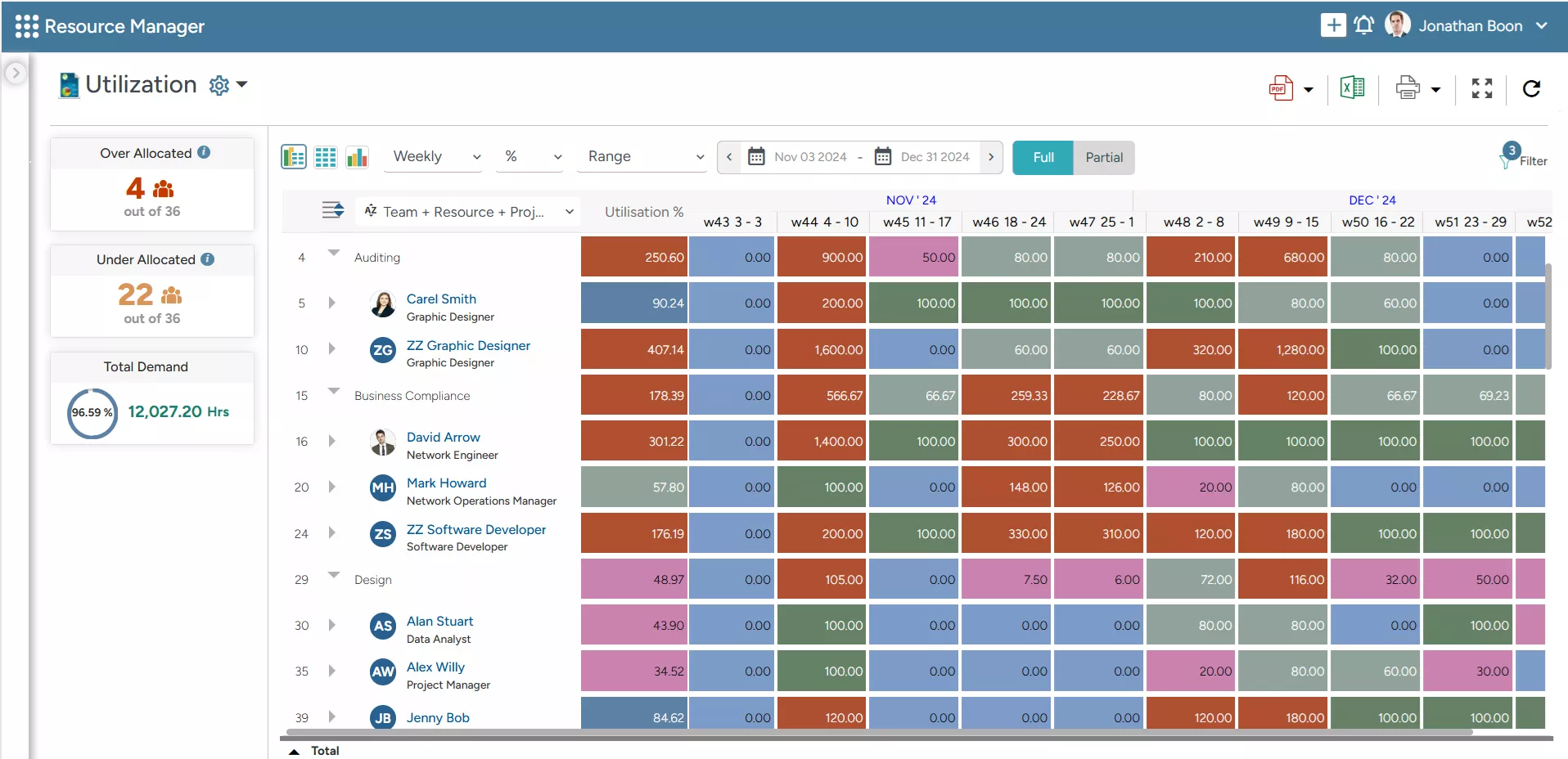 SAVIOM’s Color-Coded Embedded Heatmap provides in-depth insights into the utilization level of every resource.
SAVIOM’s Color-Coded Embedded Heatmap provides in-depth insights into the utilization level of every resource.
- The intelligent matchmaking feature helps PMO to ensure that the most competent resource is assigned to the right job at the right cost.
2. The software offers a powerful resource forecasting feature that helps PMOs anticipate future skill requirements. Moreover, with forecast vs. actual cost analysis, managers can identify financial variances and implement effective cost optimization strategies to keep projects within budget.
3. The tool also features built-in BI capabilities, enabling real-time utilization of resource plans to create customized dashboards and reports. This further simplifies decision-making for the PMO by offering relevant data in both graph and numerical formats. Moreover, the data can be customized as per business requirements.
4. Lastly, the what-if analysis feature facilitates scenario-based resource optimization, enabling the PMO to simulate different scenarios in a sandbox environment. This helps them assess the impact of various plans and arrive at the most profitable one.
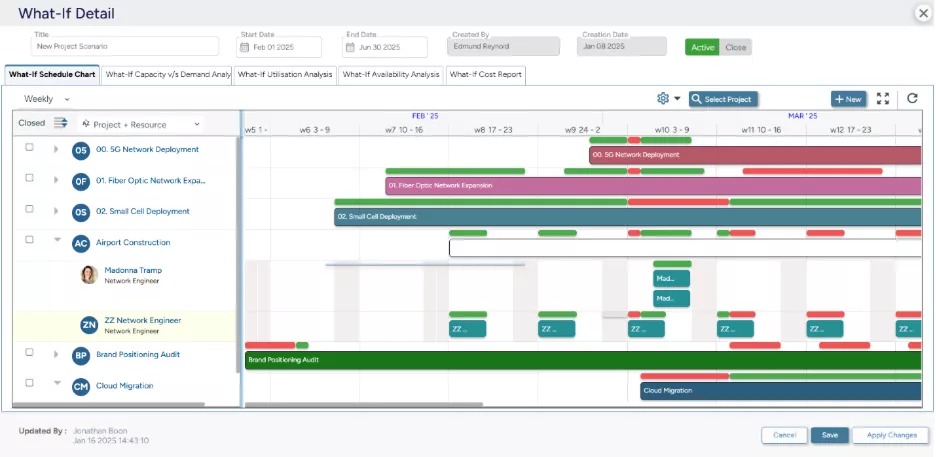 SAVIOM’s What-If Analysis dashboard helps to create various scenarios & arrive at the most profitable resource plan.
SAVIOM’s What-If Analysis dashboard helps to create various scenarios & arrive at the most profitable resource plan.
5. The platform also allows PMOs to automate key workflows such as resource requisitions, skill updates, and approval processes, streamlining operations, improving turnaround time, and ensuring consistency across departments.
Conclusion
The Project Management Office (PMO) drives project success and organizational efficiency. It encompasses various PMO roles and responsibilities that contribute to effective project management and strategic alignment within an organization. Furthermore, the PMO catalyzes continuous improvement. As a result, PMO is an indispensable part of an organization that enables it to navigate the complexities of today’s business environment and drive overall excellence.
The Glossary
Read More: Glossary of Resource Workforce Planning, Scheduling and Management
